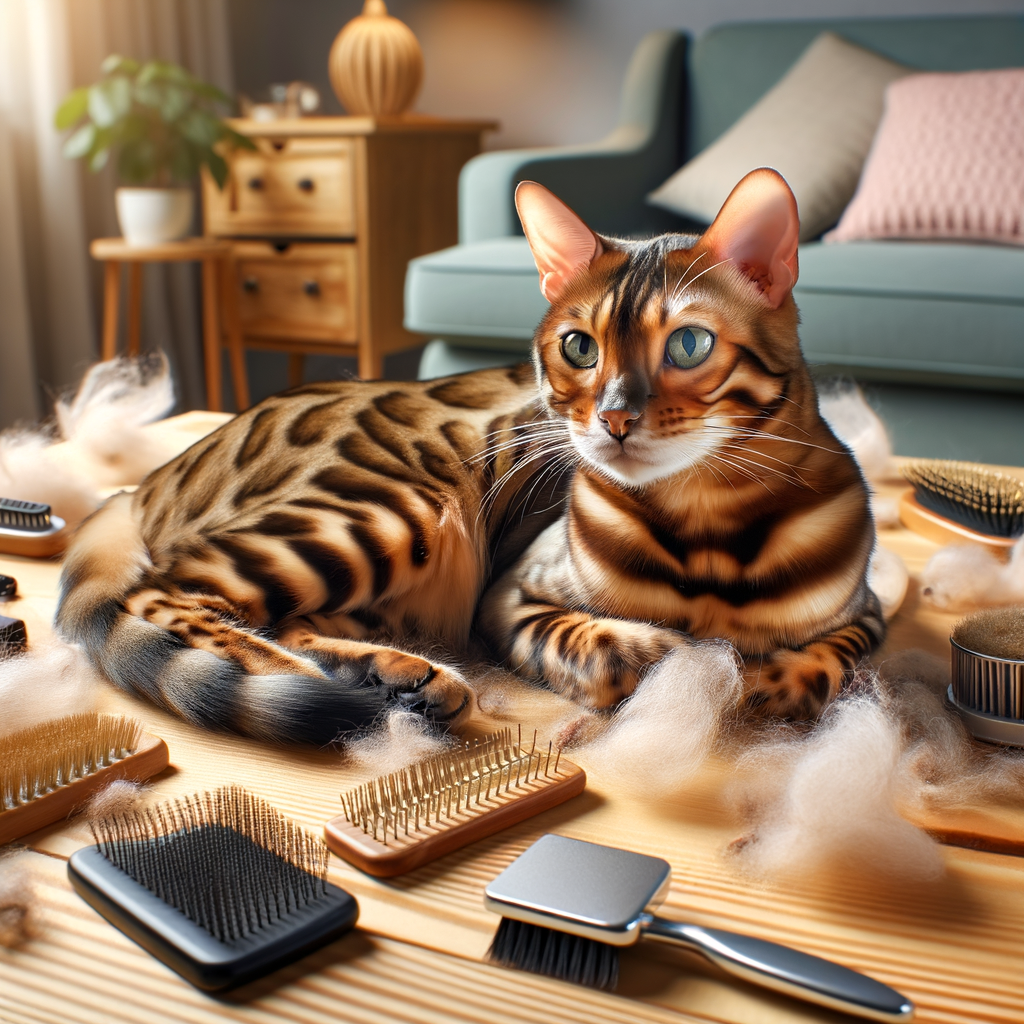
Introduction to Seasonal Shedding in Bengal Cats
Bengal cats are known for their beautiful, sleek coats. However, like all cats, they shed their fur. This shedding can change with the seasons.
- Bengal cat fur loss: Bengal cats shed their fur to get rid of old or damaged hair. This is a natural process that helps keep their coat healthy. The amount of shedding can vary depending on the time of year. For example, they might shed more in the spring and fall.
- Common misconceptions about Bengal cat shedding patterns: Some people think that Bengal cats do not shed at all. This is not true. While they may shed less than other breeds, they still lose fur. Another misconception is that shedding is a sign of poor health. In most cases, shedding is normal and not a cause for concern.
| Season | Shedding Pattern |
|---|---|
| Spring | Increased shedding as they lose their winter coat |
| Summer | Moderate shedding |
| Fall | Increased shedding as they prepare for a thicker winter coat |
| Winter | Minimal shedding |
Bengal Cat Shedding Patterns
Factors Influencing Bengal Cat Shedding
- Seasonal changes: Bengal cats, like many other breeds, shed more during certain seasons. In spring, they often lose their winter coat to prepare for warmer weather. This is called “blowing their coat.” In fall, they shed again to make way for their thicker winter coat.
- Diet and health: Cats with a balanced diet rich in omega-3 and omega-6 fatty acids tend to have healthier skin and coats. Poor health or nutritional deficiencies can lead to excessive shedding. Regular vet check-ups can help keep your cat’s shedding under control.
- Age and breed characteristics: Younger Bengal cats may shed more as they grow and their coat matures. Additionally, the unique characteristics of the Bengal breed, such as their short, dense fur, can influence how much they shed. Older cats might also shed more due to age-related health issues.
Bengal Cat Seasonal Coat Changes
- Summer shedding: During the summer, Bengal cats shed more. This is because they don’t need a thick coat to stay warm. You might notice more fur around your home. Regular brushing can help manage this shedding. According to Wikipedia, shedding is a natural process for cats to regulate their body temperature.
- Winter coat transition: As winter approaches, Bengal cats grow a thicker coat. This helps them stay warm in colder weather. You may see less shedding during this time. Keep your cat’s coat healthy with proper grooming. A study shows that a healthy diet can also support a good coat condition.
| Season | Coat Changes | Care Tips |
|---|---|---|
| Summer | Increased shedding | Brush regularly, keep hydrated |
| Winter | Thicker coat | Groom often, maintain a healthy diet |
Managing Bengal Cat Shedding
Reducing Bengal Cat Shedding
- Proper NutritionHigh-quality cat food with essential nutrients can help reduce shedding. Look for foods rich in Omega-3 and Omega-6 fatty acids. These nutrients promote a healthy coat and skin.
For example, a study from Wikipedia shows that proper nutrition can significantly improve a cat’s coat condition.
- Regular GroomingGrooming your Bengal cat regularly helps manage shedding. Use a brush designed for short-haired cats. Brush your cat at least once a week to remove loose hair and prevent matting.
Regular grooming also helps distribute natural oils through your cat’s coat, keeping it shiny and healthy.
- Health Check-UpsHealth issues like allergies or skin conditions can cause excessive shedding. Your vet can help diagnose and treat these problems.
According to Wikipedia, regular health check-ups can catch issues early, ensuring your cat stays healthy and happy.
Bengal Cat Grooming Tips
- Choosing the right grooming toolsUsing the right tools can make grooming your Bengal cat much easier. A good brush is essential. Look for a brush with soft bristles to avoid hurting your cat’s skin. A comb can help remove tangles and loose fur. You might also need nail clippers to keep their claws trimmed.
- Establishing a grooming routineAim to brush your Bengal cat at least once a week. This helps reduce shedding and keeps their coat shiny. Make grooming a positive experience by giving treats and praise.
- Professional grooming servicesSometimes, you might need help from a professional groomer. They have the skills and tools to handle any grooming challenges. Professional grooming can be especially useful if your cat has long hair or gets matted fur easily.
Bengal Cat Hair Care
Bengal Cat Fur Maintenance
- Dealing with hairballs: Bengal cats groom themselves often, which can lead to hairballs. To help your cat, brush their fur regularly to remove loose hair. This reduces the amount of hair they swallow. You can also give them special cat food designed to prevent hairballs. According to Wikipedia, hairballs are common in cats that groom themselves frequently.
- Preventing matting and tangles: Bengal cats have short, dense fur that can sometimes get tangled. To prevent this, brush your cat’s fur at least once a week. Use a soft-bristle brush to gently remove any knots. Regular brushing keeps their fur smooth and healthy. It also helps you bond with your cat.
- Spotting signs of skin conditions: Check your Bengal cat’s skin while grooming. Look for redness, bumps, or flaky skin. These could be signs of skin conditions like allergies or infections. If you notice anything unusual, take your cat to the vet. Early detection can prevent more serious health issues.
Bengal Cat Seasonal Grooming
- Adjusting grooming routines for summer and winter: Bengal cats have different grooming needs depending on the season. In summer, their fur can become oily and attract dirt. Regular brushing helps keep their coat clean and reduces shedding. In winter, their fur can become dry and brittle. Using a moisturizing shampoo can help keep their skin and fur healthy.
- Addressing common seasonal skin and fur issues: Seasonal changes can cause skin problems in Bengal cats. In summer, they may suffer from heat rashes or sunburn. Applying pet-safe sunscreen and keeping them indoors during peak sun hours can help. In winter, dry skin can lead to itching and flaking. Using a humidifier and providing omega-3 supplements can alleviate these issues.
| Season | Grooming Tips | Common Issues |
|---|---|---|
| Summer | Regular brushing, clean fur, use pet-safe sunscreen | Oily fur, heat rashes, sunburn |
| Winter | Moisturizing shampoo, humidifier, omega-3 supplements | Dry skin, itching, flaking |
Embracing Your Bengal Cat’s Seasonal Shedding
Seasonal shedding is a natural part of your Bengal cat’s life. By understanding and managing it, you can ensure your cat stays healthy and happy.
- Appreciating the beauty of Bengal cat fur: Bengal cats have stunning coats with unique patterns. Their fur is not just beautiful but also a sign of their health. Regular grooming helps maintain this beauty.
- Ensuring your Bengal cat’s comfort and health throughout the seasons: Shedding can sometimes be uncomfortable for your cat. Regular brushing and a balanced diet can make a big difference. Always keep an eye out for any unusual shedding patterns and consult your vet if needed.






